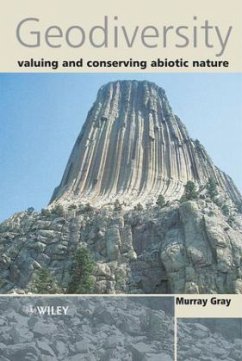A counterpoint to biodiversity, geodiversity describes the rocks, sediments, soils, fossils, landforms, and the physical processes that underlie our environment. The first book to focus exclusively on the subject, Geodiversity describes the interrelationships between geodiversity and biodiversity, the value of geodiversity to society, as well as current threats to its existence. Illustrated with global case studies throughout, the book examines traditional approaches to protecting biodiversity and the new management agenda which is starting to be used instead. Since the UN Convention on Biodiversity was signed, attention has been focused on protecting and enhancing biological diversity. However, this does not include the rocks, landforms and processes that form the physical elements of our own environment. These elements have their own diversity - a geodiversity.
Geodiversity: valuing and conserving abiotic nature is the first book to focus specifically on the geodiversity of the planet and the threats to this diversity, to explain the value of inanimate nature and to assess the approaches that should be taken to conserve it.
This text is unique in several ways:
Reviews different approaches taken around the world, including USA, Canada, Europe and Australia
Reviews new ideas including Natural Areas, Landscape Character, georestoration, landform design, sustainable use of geomaterials, Environmental Impact Assessment and Geodiversity Action Plans
Compares geo- and biodiversity, es tablishes the need for integration of nature conservation strategies, and provides a vision for the future
Beginning with an overall definition and description of geodiversity, this book examines the value of geodiversity to society and the threats that exist to it. It then goes on to survey traditional approaches to protect geodiversity and the new management agenda which is starting to be used in addition. It concludes by looking at the interrelationships of geodiversity and biodiversity and their place in sustainable land management approaches.
This book is for geologists and geomorphologists, nature conservationists, ecologists, landscape planners and architects. It would also make an excellent reference for undergraduates taking courses in Environmental Management, Nature Conservation, Resource Management or Applied Geology within Departments of Geography, Geology and Environmental Science, as well as Landscape Architecture, Planning and Archaeology.
Geodiversity: valuing and conserving abiotic nature is the first book to focus specifically on the geodiversity of the planet and the threats to this diversity, to explain the value of inanimate nature and to assess the approaches that should be taken to conserve it.
This text is unique in several ways:
Reviews different approaches taken around the world, including USA, Canada, Europe and Australia
Reviews new ideas including Natural Areas, Landscape Character, georestoration, landform design, sustainable use of geomaterials, Environmental Impact Assessment and Geodiversity Action Plans
Compares geo- and biodiversity, es tablishes the need for integration of nature conservation strategies, and provides a vision for the future
Beginning with an overall definition and description of geodiversity, this book examines the value of geodiversity to society and the threats that exist to it. It then goes on to survey traditional approaches to protect geodiversity and the new management agenda which is starting to be used in addition. It concludes by looking at the interrelationships of geodiversity and biodiversity and their place in sustainable land management approaches.
This book is for geologists and geomorphologists, nature conservationists, ecologists, landscape planners and architects. It would also make an excellent reference for undergraduates taking courses in Environmental Management, Nature Conservation, Resource Management or Applied Geology within Departments of Geography, Geology and Environmental Science, as well as Landscape Architecture, Planning and Archaeology.
"Overall, 'Geodiversity' is a most valuable addition to any geoscience library and I strongly recommend that people involved in geoconservation have a ready access to it. While the book provides us with a state-of-the-art (AD 2013), the fields of geodiversity and geoconservation are highly dynamic and the perspectives for the future seem generally promising. In this context, I hope that the strong assertion of the author that "there will not be a third edition" -- p. viii) will not prove true and in some years from now we will enjoy an updated new edition of 'Geodiversity'." -- Geologos, 1 June 2014
"It would be a fine basis for an advanced undergraduate or graduate level course and one that your students might actually read, the highest praise that I can give any textbook." -- Geological Journal, 1 June 2014
"The book can serve as an undergraduate/graduate-level textbook, but it will also have some appeal to professional geoscientist. Summing Up: Recommended. Upper-division undergraduates, graduate students, researchers/faculty, and professionals/practitioners." -- Choice, 1 July 2014
"It would be a fine basis for an advanced undergraduate or graduate level course and one that your students might actually read, the highest praise that I can give any textbook." -- Geological Journal, 1 June 2014
"The book can serve as an undergraduate/graduate-level textbook, but it will also have some appeal to professional geoscientist. Summing Up: Recommended. Upper-division undergraduates, graduate students, researchers/faculty, and professionals/practitioners." -- Choice, 1 July 2014
